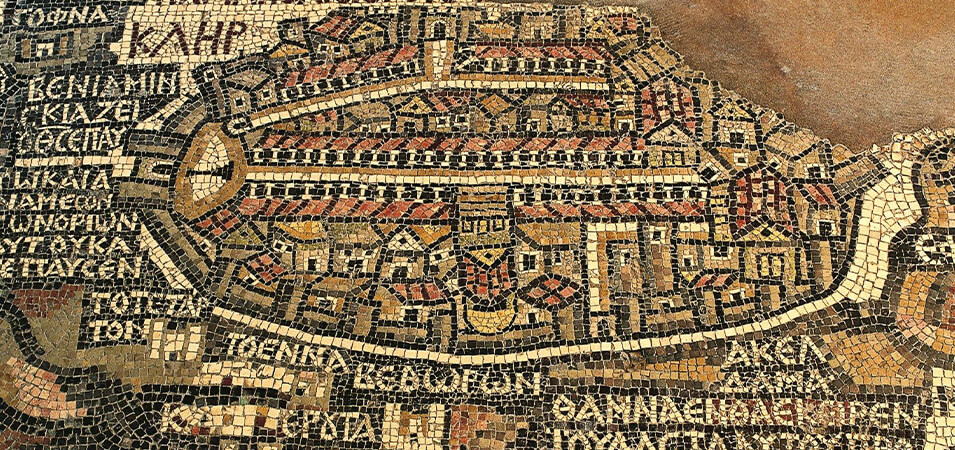Welcome to our blog post on the captivating treasure of history and artistry, the Map of Madaba Mosaic. Nestled in the ancient city of Madaba, Jordan, this extraordinary mosaic masterpiece has captivated historians, archaeologists, and art enthusiasts for centuries. This post will delve into this renowned mosaic map’s rich history, intricate details, and cultural significance.
Madaba, often called the “City of Mosaics,” holds an impressive collection of Byzantine and Umayyad mosaics. However, the crowning jewel of this mosaic heritage is undoubtedly the Map of Madaba. Discovered in 1896 during the construction of a Greek Orthodox church, this mosaic map dates back to the 6th century AD and depicts the Holy Land with astonishing precision.
As we explore the intricacies of the Madaba Mosaic, we will unravel the stories it tells about ancient cities, biblical landmarks, and pilgrimage routes. We will also shed light on the techniques employed by skilled artisans in creating this masterpiece, showcasing their exceptional craftsmanship and attention to detail.
Whether you are an avid history buff, a passionate traveler, or simply curious about the wonders of ancient art, join us on this journey to uncover the secrets and beauty of the Map of Madaba Mosaic. Prepare to be amazed by this remarkable mosaic’s artistry and historical significance.
Stay tuned for the following sections, where we will take a virtual tour of the Madaba Mosaic and delve deeper into its intriguing symbolism and cultural legacy.
Don’t Miss checking out our Jordan Travel Packages.
Location of the Map of the Madaba
The Madaba Mosaic Map is in the Church of Saint George in Madaba, Jordan. Madaba is situated approximately 30 kilometers southwest of the capital, Amman. The church is conveniently located in the city’s heart, making it easily accessible to visitors. It is a popular tourist destination, and various transportation options are available to reach Madaba, including taxis, buses, and organized tours. Once in Madaba, the church is within walking distance from the city center, making it a convenient stop for those exploring the area. Visitors can enjoy the mosaic during the church’s opening hours, which are typically aligned with regular visiting hours of religious sites.
Description of The Madaba Layout and Design
The Madaba Mosaic Map is a remarkable work of art, intricately designed and composed of thousands of colored stone tesserae. Measuring approximately 16 square meters, it covers the floor of the Church of Saint George in Madaba, Jordan. The mosaic is a visual feast featuring a complex layout that captures the attention of all who behold it. It consists of several panels, each displaying a different geographic area.
The Madaba Mosaic Map offers a fascinating interpretation of the Holy Land during the Byzantine era. It depicts a vast area stretching from Lebanon to Egypt, encompassing Palestine, Transjordan, and surrounding regions. The map showcases various cities, villages, and biblical landmarks, providing insight into the geography and history of the time. It presents a snapshot of the region’s physical features, including mountains, rivers, and the Dead Sea.
The Madaba Mosaic Map highlights numerous significant landmarks and cities. It prominently features Jerusalem, the spiritual center of the Holy Land, with its walls, gates, and important religious sites. Bethlehem, the birthplace of Jesus, is also depicted, along with Jericho, known for its biblical associations. Other notable cities illustrated include Hebron, Jaffa, and Gaza. The mosaic accurately depicts these locations and shows the region’s old geography and urban areas.
Historical Significance of Madaba
The Map of Madaba Mosaic is a significant Byzantine artifact. This amazing mosaic from the 6th century AD depicts the Holy Land at the time, making it essential for comprehending the region’s history and culture.
The mosaic illuminates the era’s geography, geology, and holy locations with its detailed intricacies and realistic renderings.
The historical Map of Madaba Mosaic shows cities, towns, monasteries, and pilgrimage sites. It emphasizes the importance of these sites in early Christianity, making it a significant resource for Holy Land academics and historians. The mosaic’s biblical subjects and people enhance its historical and theological significance.
The Map of Madaba Mosaic, preserved and restored over time, lets us appreciate Byzantine beauty and history.
The Creation of the Madaba Map
The artists and craftsmen creating the Madaba Mosaic Map showcased their expertise in mosaic artistry.
They meticulously picked and arranged each tessera to create a magnificent composition. The mosaic is one of the most significant Byzantine maps at 16 square meters.
The Madaba Mosaic Map was designed to decorate the Church of Saint George in Madaba, Jordan. It covered a large territory from Lebanon to Egypt, including essential towns, villages, and biblical sites.
The Madaba Mosaic Map needed technical expertise, geography knowledge, and religious symbolism. The artists created graphic maps and stories to orient travelers and inspire awe for biblical sites.
Today, the Madaba Mosaic Map is a testament to the ingenuity and artistic prowess of the Byzantine era. Its intricate design, vibrant colors, and the legacy it represents continue to captivate visitors.
The Biblical Significance of the Madaba Mosaic
The Madaba Mosaic Map holds immense biblical significance, serving as a visual representation of the Holy Land and its sacred narratives. Depicting numerous biblical stories and events, it offers a unique insight into the religious and cultural contexts of the time.
The mosaic showcases landmarks like Jerusalem, Bethlehem, and the Jordan River, connecting them to the stories of Jesus and the Old Testament. It is a valuable resource for scholars and pilgrims, providing a tangible link to biblical history and geography. The Madaba Mosaic Map reinforces the spiritual and historical importance of the region, reinforcing the faith and deepening understanding of biblical narratives.
Its intricate details and rich symbolism make it a cherished artifact, reminding us of biblical stories’ profound impact and lasting relevance.
Don’t Miss to Check out our Related Article :



